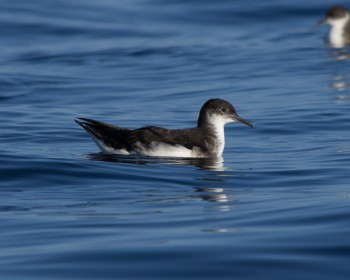
Manx Shearwater at sea, photograph by Nathan Fletcher
Annette Fayet (Department of Zoology, University of Oxford, UK) and colleagues have published online in the open-access journal Marine Ornithology on the migration route of western Atlantic Manx Shearwaters Puffinus puffinus.
The paper’s abstract follows:
“Manx Shearwaters are transequatorial migrants, and most of the world's population breeds in Britain and winters off the Patagonian Shelf in the western South Atlantic. The migration route of British birds follows a well-known clockwise movement between the North and South Atlantic, taking advantage of the winds. Whether this main Manx Shearwater migration corridor is used by the smaller populations breeding in the western North Atlantic is unknown. Here, we report our findings from tracking two adults from a newly-established colony of Manx Shearwaters in Maine, USA using miniature geolocators. The tracked shearwaters followed a post-breeding migration route southward along the US East Coast, through the Caribbean Sea, and along the coast of eastern South America. Such a route greatly differs from the western North Atlantic birds' southbound migration route, being instead the reverse of the British birds' spring migration route. We also used the tracking data to provide insight into the phenology of the birds' annual cycle. Although our sample size is very small, our findings reveal a previously unknown migration route of Manx Shearwaters and raise questions about the origin of birds on western North Atlantic colonies and the mechanisms controlling migratory direction in the species.”
Reference:
Fayet, A.L., Shannon, P., Lyons, D.E. & Kress, S.W. 2020. Manx shearwaters Puffinus puffinus breeding in the western Atlantic follow a different migration route from their eastern Atlantic conspecifics. Marine Ornithology 48: 179-183.
John Cooper, ACAP Information Officer, 17 July 2020

 English
English  Français
Français  Español
Español